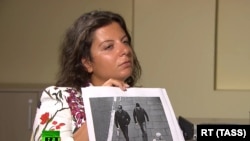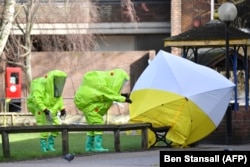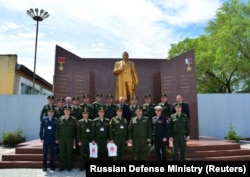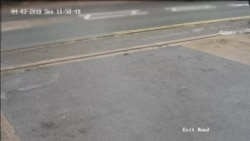On Monday, March 4, the one-year anniversary of the poisoning of Sergei and Yulia Skripal, Russian state-broadcaster RT published an article in its “news” section seeking to deny the Kremlin’s hand in the nerve agent attack on the former Russian spy and his daughter.
Writing in its informal style, RT ironically referred to the crowd-funded investigative website Bellingcat as “sleuths” and “detectives” for the journalists role in identifying the Russian military intelligence agents who are accused of carrying out the Salisbury, England attack.
RT wrote that “the intrepid Atlantic Council-backed ‘open-source’ sleuths at Bellingcat pounced on the case, finding two Russians who were in Salisbury on March 4, naming them as suspects and accusing them of being GRU (Rusian military intelligence).”
RT said the suspects, operating under the aliases Alexander Petrov and Ruslan Boshirov, claimed to be “just friends, civilians, tourists who went to Salisbury to visit the famous cathedral.” It dismissed that the two could have carried out the attack because it was seemingly botched.
That skepticism apparently is based on a statement by former Scotland Yard detective Charles Shoebridge, who earlier told RT the suspects had left “what seems to be a very reckless and clear trail of evidence, which almost seems to be designed, or at least would almost inevitably lead to the conclusions that the police and the authorities have come to today … So many mistakes were made, if indeed they were mistakes."
Shoebridge is seen often on RT. His comments, in this instance, included no new factual information.
In its March 4 piece, RT wrote: “The ‘detectives’ at Bellingcat were not satisfied with “identifying” Petrov and Boshirov. They set out to prove the men were actually super-secret Russian spies.” It added that Bellingcat found that Boshirov “was really highly decorated commando Colonel Anatoly Chepiga, and Petrov was likewise a distinguished military physician Aleksandr Mishkin.”
Despite RT’s use of sarcasm in its attempt to undermine Bellingcat’s credibility, its anniversary article does not offer new evidence – even misstating the timeline of the investigation. RT appears to credit Bellingcat for “naming them as suspects and accusing them of being GRU.”
However in early September, nine days before Bellingcat’s first report documenting peculiarities in the duo’s passports and background, police in the UK identified Petrov and Boshirov. On that same day, British Prime Minister Theresa May told the House of Commons the men were Russian agents.
Following a late September Bellingcat article that identified Chepiga, who grew up in a small village near Russia’s border with China, the accused agent was identified by local residents.
One woman told the Russian daily Kommersant that Chepiga served in “the secret service” in various “hot spots” after graduating from a military academy. Another told the BBC: "I know where his parents used to live, that he was a military man. An officer. He fought in war zones, then he was in Moscow.”
She added: "It's him in the photos, of course."
Former neighbors also confirmed that Petrov was in fact Mishkin.
Yevgeny Sergeyevich, who grew up in Miskhin’s home village of Loyga, told the Telegraph: “He [Mishkin] became a Hero of Russia three or four years ago. I heard about it from acquaintances in Loyga who are still in touch with him.”
At the Far Eastern Military Academy where Chepiga was enrolled, Radio Liberty also found his portrait among those who had received the Hero of the Russian Federation award.
Meanwhile, CCTV footage placed Chepiga and Mishkin on Wilton Road near the Skripals’ home in Salisbury the day before the military-grade nerve agent Novichok was sprayed on the victims’ door.
The police timeline had the suspects returning to Moscow on the same day the Skripals were poisoned.
As noted by the Guardian, Chepiga and Mishkin’s Salisbury trip account, in the September 2018 RT broadcast, does not “add up.”
Ironically, the RT piece says “there has been no shortage of often fanciful theories emanating from UK officialdom and NATO-backed ‘open-source detectives’ such as Bellingcat, but none have taken the world closer to knowing what actually happened.”
Just weeks after the attack, RFE/RL reported that the official Russian narrative was changing on a near daily basis.
Kings College London, last week, released a report that said Russian state media had published 138 narratives regarding the alleged Novichok attack, which the Russian Embassy in the UK characterized as “separate points on various aspects of the incident” rather than separate “accounts” or “versions.”
One of those “separate points” included the theory that two of the suspects in the attack were in fact British actors starring in a non-existent KGB spy series broadcast on British television in the 2000s, the BBC reported.
Ben Nimmo, a senior fellow at the Atlantic Council, told the British state-funded broadcaster: "The more different theories you put out, the more different Google results you're going to get. So instead of seeing two or three different versions of the story you're seeing 20 or 30. And for someone who is not following the story regularly that becomes more and more confusing until they give up. And at that point, the Russian disinformation has had its effect."
Polygraph finds that RT’s claim regarding Bellingcat, along with its selective omission of facts, to be misleading.











